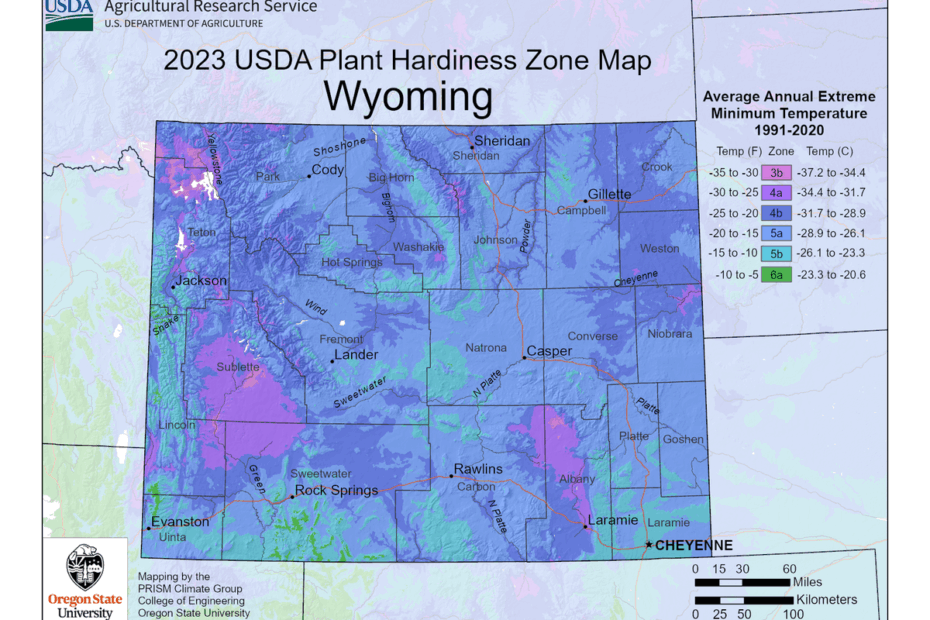Wyoming, a canvas painted with sweeping plains, majestic mountains, and untamed wilderness, is a state as enigmatic as it is captivating. Amidst its rugged beauty lies a delicate world of foliage dancing with the elements, reminding us of the harmonious dance between man and nature. But as we journey through this vast expanse of untrodden territory, an intriguing question arises: what plant zone is Wyoming? Unlocking the secrets of this ecological wonderland demands a closer exploration, as we dive into the intricate tapestry of plant life that thrives within the boundaries of the Equality State. So, grab your magnifying glass, don your explorer’s hat, and join us on an adventure to unveil the mysteries of Wyoming’s plant zones!
The Natural Characteristics of Wyoming’s Plant Hardiness Zone
Wyoming’s unique climate and geography contribute to its diverse plant hardiness zone. Situated in the Rocky Mountains region of the United States, Wyoming experiences extreme temperature fluctuations and varying soil types, which impacts the types of plants that can thrive in different areas of the state.
Within Wyoming, the plant hardiness zones range from zone 3 in the higher mountainous regions to zone 5 in the lower elevations. These zones provide valuable information to gardeners and plant enthusiasts, indicating the average minimum temperatures experienced in different parts of the state. This knowledge helps determine which plants are likely to survive and flourish in specific zones, supporting successful gardening projects throughout Wyoming.
| Features | Tips |
|---|---|
| Harsh winters and short growing seasons | Choose cold-hardy plants that can withstand freezing temperatures and have shorter maturation periods. |
| Varied soil types, from sandy to clay | Understand the soil composition in your specific zone and select plants that are well-suited to thrive in those conditions. |
| Strong winds and low humidity | Plant wind-resistant species and provide windbreaks to protect delicate plants. |
Wyoming’s plant hardiness zones offer a world of possibilities, from hardy perennials and alpine flowers in the mountainous regions to drought-tolerant natives and grasses in the lower elevations. Understanding these natural characteristics is crucial for successful gardening and landscaping in Wyoming, as it allows plants to thrive and adapt to the unique conditions of the region.

Understanding the Plant Hardiness Zones in Wyoming and Their Key Features
Wyoming, the picturesque state nestled in the heart of the Rocky Mountains, is known for its stunning natural beauty and diverse plant life. Understanding the plant hardiness zones in Wyoming is crucial for any avid gardener or horticulture enthusiast looking to thrive in this unique environment. With varying elevations and extreme weather conditions, Wyoming offers a range of planting challenges and opportunities.
Here are so
me key features to consider when navigating the plant hardiness zones in Wyoming:- Zone Variety: Wyoming encompasses multiple plant hardiness zones, ranging from 3a in the coldest regions to 7a in the mildest. This variation allows for an array of plant options, with each zone cultivating its own set of flora suited to the local climate and growing conditions.
- Elevation Impact: As you venture higher in Wyoming, the elevation increases, leading to colder temperatures and shorter growing seasons. It’s crucial to choose plants adapted to these conditions to ensure successful growth and survival.
To pr
ovide further insight into the various plant hardiness zones in Wyoming, here is a table highlighting some key features and tips for each zone:| Zone | Features | Tips |
|---|---|---|
| 3a | – Lowest temperatures – Short growing season |
– Choose hardy plants – Start seeds indoors or use season extenders |
| 7a | – Mild winters – Longer growing season |
– Explore a wider range of plants – Take advantage of longer growing period |
| … (other zones) | … | … |
Wyoming’s plant hardiness zones hold an abundance of natural wonders waiting to be cultivated. By understanding the unique characteristics of each zone and utilizing appropriate plant selections, you can create a vibrant and thriving garden amidst the wild landscapes of this remarkable state.
Optimal Plant Selection and Gardening Tips for Wyoming’s Unique Climate
<h3>Plant Zones in Wyoming</h3>
<p>Wyoming is known for its diverse climate, making it essential for gardeners to know the appropriate plant zones. The state is predominantly located in USDA Hardiness Zones 3a to 6b. These zones provide valuable information about the minimum temperatures a region can experience, helping gardeners identify plants that can thrive in Wyoming's challenging climate. Factors such as elevation, topography, and temperature variations across the state further contribute to its unique plant zones.</p>
<h3>Features and Tips</h3>
<table>
<tr>
<td>
<ul>
<li><strong>Drought-Tolerant Plants:</strong> Due to Wyoming's arid climate, it is crucial to select plants that can withstand extended periods of drought. Consider species like Russian Sage, yarrow, and penstemon, which are hardy and require minimal watering.</li>
<li><strong>Frost-Resistant Varieties:</strong> Given the state's fluctuating temperatures, it is advisable to choose plants capable of tolerating late spring frosts or early fall freezes. Opt for cold-hardy flowers such as pansies, dianthus, and snapdragons.</li>
</ul>
</td>
<td>
<ul>
<li><strong>Native Plants:</strong> Emphasize native species in your garden as they are more likely to adapt well to Wyoming's climate. Native wildflowers like Indian paintbrush, lupine, and goldenrod can add vibrant colors to your landscape while supporting local ecosystems.</li>
<li><strong>Wind-Resistant Trees:</strong> Wyoming experiences gusty winds, especially in open areas. Incorporate wind-resistant tree varieties like Rocky Mountain juniper, Austrian pine, or Bur oak to ensure your garden remains resilient against strong winds.</li>
</ul>
</td>
</tr>
</table>

